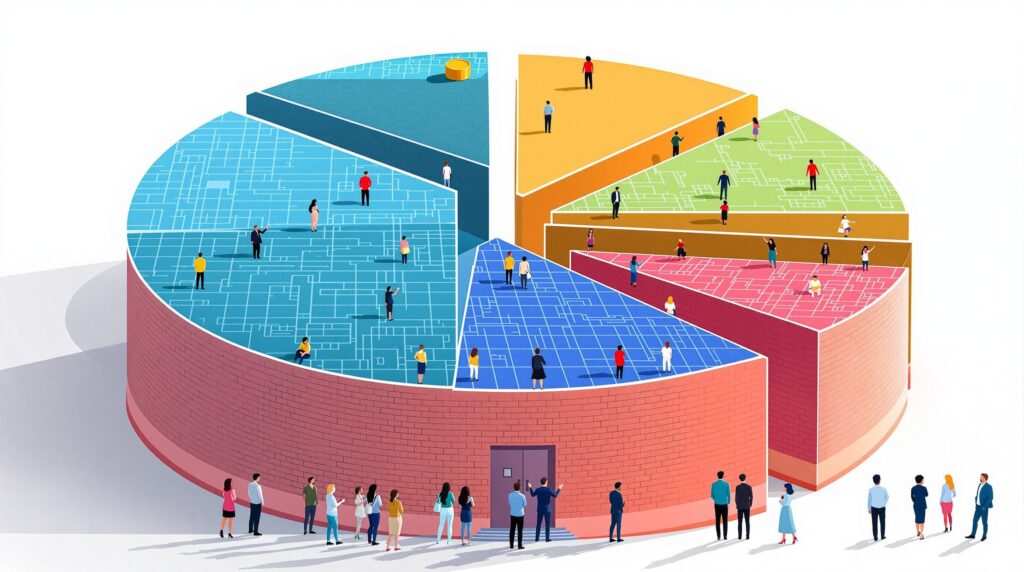[rev_slider alias=”slider-1″][/rev_slider]
Understanding Layer 1 Blockchains
Imagine a bustling city where everything from transportation to communication runs smoothly due to well-laid roads and sturdy bridges. These roads and bridges are akin to Layer 1 blockchains in the digital world — the fundamental infrastructure that supports all operations, or in this case, transactions and smart contracts.
Key Features of Layer 1 Solutions
Layer 1 blockchains, often called the backbone of any blockchain network, are crucial for ensuring the network’s security, decentralization, and scalability. But what really sets them apart from other solutions?
- Security: This is the fortress protecting the city. Layer 1 blockchains utilize complex cryptographic techniques to ensure that the transactions are tamper-proof and secure, keeping your digital assets safe from unauthorized access.
- Decentralization: Imagine a democratic city where everyone has an equal say. Layer 1 blockchains distribute authority across multiple nodes, preventing any single entity from gaining exploitative control. This enhances transparency and trust within the network.
- Scalability: As a city grows, so does the need for roads. Scalability in blockchain terms means the ability to increase the network’s capacity to handle a growing number of transactions without compromising speed or efficiency.
What is a Layer 1 blockchain? A Layer 1 blockchain is the base-level infrastructure of a blockchain network, providing security, decentralization, and scalability to support all decentralized applications and transactions.
The significance of these features cannot be overstated, especially in regions like Africa, where digital financial services are becoming increasingly critical. Companies like Jara are pioneering efforts to bridge global capital to African assets through robust blockchain infrastructures, ensuring the continent’s participation in the digital economy is both efficient and secure.
With the rise of cryptocurrency and blockchain technology, understanding these layers not only benefits investors but also empowers local economies to thrive in the global marketplace. The role of Layer 1 blockchains forms a critical piece in this digital transformation puzzle, making them a key area to watch and invest in, especially for pioneering projects like $JARA.
Stay tuned as we explore the implications of these advancements further and delve into specific emerging Layer 1 blockchains that are capturing the world’s attention.
Emerging Layer 1 Blockchains to Watch
Discover the top 5 emerging Layer 1 blockchains that are making waves in the industry. Learn their unique propositions and potential impact on Africa’s burgeoning tech landscape. With Africa positioned as a dynamic market, these advancements stand to significantly influence the continent’s digital future.
Highlighting Pioneering Projects
Explore specific projects within these blockchains that showcase innovation and potential for growth. Each of these blockchains provides unique solutions that cater to the demands of a growing digital economy and integrate smoothly with Africa’s aspirations.
What is a Layer 1 Blockchain? A Layer 1 blockchain is the foundational layer of a blockchain network, responsible for the core functionalities such as scalability, security, and transaction processing speed.
- Key Concept: Each blockchain offers distinct attributes that can reshape Africa’s digital infrastructure. They cater to the growing demands for decentralized finance, secure transactions, and efficient asset management.
- Investment Potential: By investing in these Layer 1 blockchains, stakeholders get to partake in the growth of new technological advancements and economic progression within the continent.
“These emerging blockchains are not just investments; they are building blocks for Africa’s digital transformation.” – Jara, Bridging Global Capital to African Assets
1. Polkadot
Polkadot stands out with its ability to enable different blockchains to transfer messages and value in a trust-free fashion; sharing their unique features while pooling their security. This ability is critical for facilitating the integration and digital convergence throughout diverse African markets.
Its multichain approach surpasses the limitations of previous blockchain networks. By facilitating cross-chain communication, Polkadot brings a collaborative ecosystem that aligns with Africa’s goal for regional cooperation in digital advancements.
2. Cardano
Cardano’s emphasis on sustainability, scalability, and transparency offers a robust platform for building decentralized applications crucial to addressing local African needs. Its evidence-based research model champions security and encourages innovation tailored to emerging market requirements.
By anchoring its proposition on academic insights, Cardano not only stands to impact localized financial inclusion projects but also to facilitate educational growth about blockchain technology across Africa.
3. Solana
As a powerhouse known for its rapid transaction speeds and low costs, Solana offers a conducive environment for building decentralized apps tailored for African markets. This capability is particularly useful in locations where accessibility and cost can be significant barriers.
Solana’s performance surpasses many existing solutions, paving the way for more effective settlement systems, increased adoption of financial services, and a robust template for handling real-world transactions efficiently.
4. Avalanche
Avalanche provides an open, programmable smart contracts platform for decentralized applications. The blockchain has secured a niche for itself by providing nearly instant transaction finality, which is crucial in industries like supply chain and logistics pivotal to Africa’s economy.
With its high throughput exceeding thousands of transactions per second, Avalanche sets the stage for scalable and resilient ecosystems capable of supporting Africa’s ambitious infrastructural projects.
5. Terra
By focusing on creating stablecoins tied to various fiat currencies, Terra remains positioned to solve currency volatility problems persisting across many African countries. Its algorithmic approach aligns with economic strategies seeking to enhance monetary stability and consumer trust.
Offering programmable payments and logistics, Terra aids in building practical financial products that extend beyond traditional banking systems, enabling a patient navigation of the African financial landscape.
In summary, these emerging Layer 1 blockchains represent not just technological innovation but a transformative opportunity to drive Africa’s digital economy forward. By integrating these blockchains with African assets, there’s immense potential to open new avenues for investment and development.
[rev_slider alias=”text-call-cta”][/rev_slider]
Layer 1 vs Layer 2 Blockchain Solutions
In the world of blockchain technology, Layer 1 and Layer 2 solutions play pivotal roles in shaping the future of digital transactions. Let’s delve into their individual characteristics and explore how they complement each other in the quest for scalability.
Understanding Layer 1 Solutions
Layer 1 blockchain solutions are the foundational blockchains themselves, like Bitcoin and Ethereum. These are the bedrock of any blockchain ecosystem, responsible for maintaining the network’s integrity and security. However, their scalability issues, such as slower transaction speeds and higher costs, can pose challenges as adoption grows.
The key distinction is that Layer 1 solutions form the core protocol, responsible for data integrity and security, while Layer 2 solutions aim to enhance these base layers by improving scalability and efficiency.
Defining Layer 2 Blockchain Solutions
So, what’s Layer 2 all about? Layer 2 solutions function on top of Layer 1 blockchains, essentially serving as off-chain extensions. They alleviate the aforementioned limitations by facilitating more transactions without altering the core protocol. Notables like the Lightning Network on Bitcoin and Ethereum’s Optimistic Rollups exemplify these enhancements.
- Lightning Network: Designed to improve Bitcoin’s transaction speed and scalability by creating off-chain payment channels.
- Optimistic Rollups: Ethereum’s solution for bundling multiple transactions into one, improving efficiency and reducing on-chain activity.
Advantages of Layer 2 Enhancements
Layer 2 solutions present numerous advantages that significantly enhance the capabilities of Layer 1 blockchains. Let’s break down some key benefits:
- Increased Scalability: By processing transactions off-chain, Layer 2 solutions alleviate network congestion, allowing for a higher volume of transactions.
- Cost Efficiency: Reduced transaction fees are a huge win for users, making it more economical to engage in blockchain activities.
- Faster Transactions: Transactions that occur on Layer 2 are processed more swiftly, providing users with a more seamless experience.
- Enhanced User Experience: Thanks to the improved performance, users can enjoy smoother interactions with blockchain applications.
“Your Voice, Our Mission” – at Jara, we integrate these innovative solutions to bolster Africa’s digital asset economy, providing you with a pathway to beneficial and scalable investments.
The Role of Jara in Layer 2 Development
Jara is not only monitoring these developments but is integrating them to enhance the financial landscape across Africa. With our proprietary Layer 2 blockchain, we focus on empowering users and providing secure, rapid transactions across our Jara Wallet. The synergistic interaction between our Layer 1 and Layer 2 solutions is pivotal to bridging global capital to African assets efficiently.
Layer 1 and Layer 2 together create a balanced ecosystem where security meets scalability. To truly understand the potential, think of Layer 2 as adding an express lane to a busy highway (Layer 1). More traffic passes smoothly without needing to expand the road, symbolizing how Layer 2 eases the load.
Are you ready to dive into the future of digital investments? Explore our Jara ecosystem and witness how these innovations are reshaping the African digital asset landscape.
Future Trends in Layer 1 Blockchain Development
The blockchain landscape is rapidly evolving, and Layer 1 blockchain technologies are at the forefront of this transformation. How are these foundational blockchains expected to evolve in the coming years, and what implications might this have for global industries?
What is a Layer 1 Blockchain? A Layer 1 blockchain is the foundational layer of a blockchain ecosystem, providing the base network and protocol that other applications and layers build upon, enabling decentralized applications and transactions in a secure and open environment.
Impact on Global Capital Markets
Advancements in Layer 1 blockchains are set to significantly influence capital inflow into emerging markets, particularly in Africa. These blockchains promise faster, more secure, and cost-efficient transaction processes that can support economic growth and attract global investments. Could this technological leap be the key to bridging the global capital with African assets?
The ability of Layer 1 blockchains to provide a secure, decentralized infrastructure is not only transforming traditional financial systems but is also unlocking new opportunities for investment in real-world assets, such as the proposed tokenization of infrastructure projects. For example, the Jara platform aims to digitize illiquid African assets, enabling their availability on global markets.
- Increased Financial Inclusion: By lowering barriers to entry, Layer 1 blockchains can provide financial services to underbanked populations, fostering greater economic participation and empowerment.
- Enhanced Security and Efficiency: With improved security protocols and faster transaction speeds, Layer 1 advancements can streamline financial operations, reducing risks and costs associated with traditional banking methods.
- Tokenization of Real-World Assets: Projects like Jara’s tokenization of the Lagos airport highlight how blockchains can make significant infrastructure assets accessible to global investors, unlocking capital previously tied up in non-accessible forms.
“Invest in $JARA: Fuel Africa’s $200B+ Digital Asset Economy and Participate in a Revolutionary Ecosystem” reflects the growing interest and opportunities in African markets catalyzed by innovative blockchain solutions like Jara.
As researchers and developers continue to advance Layer 1 technologies, their potential to reshape entire sectors becomes increasingly evident. However, the true impact will hinge on regulatory landscapes, user adoption rates, and technological resilience. How will the interaction between these forces shape the future of global capital distribution?
Technological Innovations and Global Expansion
One cannot overlook the influence of technological innovation on future trends. Concepts like scalability enhancements, interoperability between chains, and new consensus mechanisms are key focus areas for developers. How do these innovations promise to sustain the global expansion of blockchain technology?
- Interoperability: The ability of different Layer 1 blockchains to communicate and transact with each other is crucial. Enhanced interoperability can lead to more integrated and versatile applications spanning global markets.
- Scalability: Solutions aimed at increasing transaction capacity and reducing latency could enable broader adoption across various industries, making blockchain a viable option for large-scale deployments.
- Eco-Friendly Technologies: With growing awareness of environmental impacts, emerging technologies are focusing on reducing energy consumption through more efficient protocols, building a more sustainable blockchain ecosystem.
The development of Proprietary Layer 2 blockchains like Jara’s Caldera-based solution aims to address current limitations of Layer 1 with low fees and high transaction speeds, enhancing their global usability.
In conclusion, the evolution of Layer 1 blockchains presents both challenges and opportunities for global capital markets. Stakeholders, including investors, regulators, and technology developers, must navigate these waters carefully. Will the proliferation of these technologies democratize access to capital, or will they reinforce existing divides? The future trends of Layer 1 development will indeed be pivotal in answering these questions.
For more information on how these trends integrate into the African market and opportunities for investment, explore the legal implications of cryptocurrency adoption.
[rev_slider alias=”schedule-consultation-btn”][/rev_slider]

What distinguishes Layer 1 blockchains from Layer 2 solutions?
The primary distinction of Layer 1 blockchains lies in their fundamental structure, acting as the base layer upon which other blockchain layers are built. Layer 1 blockchains encompass the grassroots innovations in decentralization, security, and consensus protocols. They are self-sufficient networks, unlike Layer 2 solutions which are built on top of them to enhance scalability and speed through off-chain processes.
Key differences:
- Independence: Layer 1 operates independently, while Layer 2 relies on Layer 1.
- Scalability: Layer 2 primarily addresses scalability and speed limitations of Layer 1.
- Security: Security features are inherent in Layer 1, while Layer 2 leverages these features.
Are Layer 1 blockchains better than Layer 2?
Layer 1 blockchains are not necessarily superior to Layer 2 solutions; rather, they serve distinct purposes. Layer 1 provides the essential groundwork that ensures security and integrity, while Layer 2 solutions offer enhancements like faster transaction processing and reduced costs. The combination of both supports the overall functionality and performance of the blockchain ecosystem.
Conceptual comparison:
- Foundation vs. Enhancement: Layer 1 as foundational; Layer 2 as an enhancement.
- Efficiency: Layer 2 delivers improved efficiency in transaction processing.
How do Layer 1 blockchains ensure decentralization?
Layer 1 blockchains ensure decentralization through their network design, where consensus is reached by multiple, independent nodes across the globe. This distribution minimizes the risk of central authority control and enhances security through consensus mechanisms like Proof of Work (PoW) or Proof of Stake (PoS).
Core decentralization factors:
- Node Distribution: Globally distributed nodes prevent central control.
- Consensus Mechanisms: Use of PoW and PoS to establish trust and security.
What is the future potential of Layer 1 blockchains?
The future potential of Layer 1 blockchains is significant, particularly in sectors demanding robust security and decentralization. Innovations in this layer can lead to more efficient and scalable solutions, unlocking new use cases in industries ranging from finance to supply chain management. As emerging ecosystems like the Jara ecosystem evolve, Layer 1 advancement will be crucial to supporting Africa’s digital asset economy, exemplifying the vast opportunities that these foundational technologies offer.
Future trends:
- Industry Integration: Layer 1’s role in integrating with traditional markets.
- Scalability Innovations: Enhancements that boost efficiency and reduce costs.

Related Practice Areas
Explore other areas related to Layer 1 blockchain solutions that might interest you.
Hear From Our Satisfied Clients
At the forefront of our Layer 1 blockchain solutions services is a deep-seated commitment to client satisfaction. Each project is handled with utmost care, as echoed in the appreciative feedback from those we represent.

[rev_slider alias=”slider-3″][/rev_slider]
[rev_slider alias=”slider-6″][/rev_slider]
Contact Jara for Expert Blockchain Solutions
As you navigate the ever-evolving landscape of blockchain technology, partnering with experts can make all the difference. At Jara, we are dedicated to bridging global capital to African assets, transforming visions into reality through strategic blockchain solutions. Whether you’re pioneering Layer 1 or Layer 2 applications, our team is here to guide you every step of the way. Now’s the time to revolutionize your blockchain strategies with our unparalleled expertise. Reach out to us today via [email protected] or download the Jara app on Android or iPhone.
“Your innovation deserves a partner that understands the intricacies of blockchain. Let’s unlock the potential of your projects together.”
Jara’s Recent Recognitions
- Highlighted: Among the “Top Blockchain Innovation Firms in Africa” 2023 by Blockchain Africa Conference. View Award
- Listed: As one of the “Best Emerging Tech Companies in Lagos” 2023 by African Innovation Awards. View Award
- Recognized: Among the “Leading Blockchain Solution Providers 2023” by Global Finance Journal. View Award
- Cited: For excellence in “Decentralized Finance Innovation” by the Digital Economy Council 2023. View Award
- Featured: Among the “Top Tech Disruptors in Africa 2023” by Tech Horizons Magazine. View Award
Chinyere “Chi” Nnadi Bio
Founder and CEO, Jara | Blockchain Technology Specialist
Content Reviewed by Chi Nnadi and his Content Team. Chi is a visionary entrepreneur driving Africa’s financial evolution through innovative blockchain solutions. As the Founder and CEO of Jara, he is pioneering the transformation of illiquid African assets into digital tokens accessible worldwide. With a robust Layer-1 blockchain platform, Chi connects international investors with Africa’s emerging digital asset landscape.
Our Content Review Process
Chi Nnadi, together with Jara’s expert content team, is committed to delivering exemplary content. Our guidelines prioritize thorough research, authoritative sources, and impartial review standards. We welcome feedback if you notice any inaccuracies or require additional clarification.
















